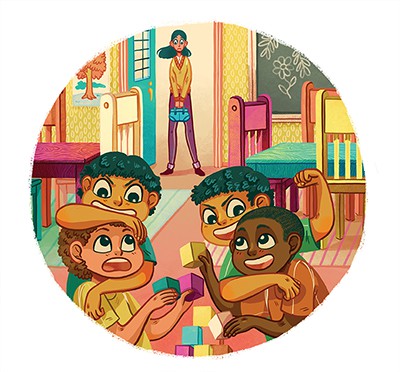LETTING BOYS BE BOYS MAY BE THE BEST APPROACH
STORY BY Heather Kirk-Davidoff ILLUSTRATION BY Kelly Miller
When my twins were 4 years old, I was seriously concerned they were psychopaths. I shouldn’t have worried. They were just boys.
The cause of my alarm wasn’t just the joy they took in destroying things in our house or biting each other. I really got worried once they started preschool. Each morning, 
I was horrified. Where did they learn to act like that?
My mother made sure her daughter knew from an early age that girls could do anything boys can do. On the soundtrack of my childhood, “Free to Be You and Me,” Marlo Thomas and friends cheerfully proclaim that girls can run as fast as boys and that it is perfectly okay for a boy to want to be a cocktail waitress when he grows up. I took it all to heart. Aside from anatomy, I was certain there were no essential differences between males and females. Until I had children.
I made sure that dolls shared my sons’ toy box with the trains and trucks and blocks. As far as I can tell, the only use they found for the dolls was to throw them at each other. When my daughter came along, I was happy to see that she was as interested in Thomas the Tank Engine as her brothers had been. But while the boys built long, complicated tracks to stage multiple train accidents, my daughter arranged the engines in family groups. Edward was married to Annie and they were the parents of Thomas, she told me. Her trains kissed each other’s boo-boos and tucked each other into bed at night.
My kids have taught me that boys and girls come into the world with different wiring. I want to be careful about the conclusions I draw from this — biology is not destiny. Much of our gender expression is a result of social conditioning. Most of the girls I know enjoy pushing friends into the pool or shoving their siblings off the hammock. But I have come to believe that rough play has importance in boys’ lives that it just doesn’t seem to have in girls.’
Psychiatrist Dr. Stuart Brown, founder of the National Institute for Play, drew that conclusion from research on murderers. Many of the violent men he studied had not been allowed to play as children. Brown went on to study play in laboratory rats. He discovered that rats prohibited from rough-and-tumble play as juveniles will have difficulty distinguishing friend from foe as adults. The deprived rats are aggressive in the wrong situations. They can’t distinguish a playful push from a real threat.
It’s possible that the behavior I initially saw as a sign that my boys were psychopaths was exactly the opposite.
These days, it is hard for boys to roughhouse anywhere adults are watching. Schools are on the lookout for bullying behavior and rough play is forbidden on the playground. Boys’ wrestling is relegated to a closely supervised setting with protective headgear. Mostly this seems like good news — who has fond memories of getting beaten up on the playground? Even so, sometimes I wonder if the only remaining outlet for children’s aggression – video games – is enough. When kids shoot at each other’s screen avatars, are they learning what really hurts and when they need to back off?
Years ago, when my boys were in early elementary school and far from civilized, our family had a chance to go white water rafting. After the initial shock of dramatic rapids, we reached a calm stretch in the river where we could catch our breaths. When the kids weren’t looking, the guide handed my husband a pump and encouraged him to shower the boys with water. The twins were shocked and offended — until the guide tossed them squirt guns of their own. An epic battle ensued and I ended up overboard. It was a great reminder that a little roughhousing won’t break us. In fact, it might bring us closer to each other.*
Heather Kirk-Davidoff is the Enabling Minister of the Kittamaqundi Community Church in Columbia. She and her husband, Dan, are the parents of three biological children and an adult foster daughter.




